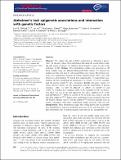Alzheimer's loci: epigenetic associations and interaction with genetic factors
Author(s)
Chibnik, Lori B.; Yu, Lei; Srivastava, Gyan; Schneider, Julie A.; Kellis, Manolis; Bennett, David A.; De Jager, Philip L.; Eaton, Matthew Lucas; ... Show more Show less
DownloadKellis_Alzheimer's loci.pdf (457.6Kb)
PUBLISHER_CC
Publisher with Creative Commons License
Creative Commons Attribution
Terms of use
Metadata
Show full item recordAbstract
Objective
We explore the role of DNA methylation in Alzheimer's disease (AD). To elucidate where DNA methylation falls along the causal pathway linking risk factors to disease, we examine causal models to assess its role in the pathology of AD.
Methods
DNA methylation profiles were generated in 740 brain samples using the Illumina HumanMet450K beadset. We focused our analysis on CpG sites from 11 AD susceptibility gene regions. The primary outcome was a quantitative measure of neuritic amyloid plaque (NP), a key early element of AD pathology. We tested four causal models: (1) independent associations, (2) CpG mediating the association of a variant, (3) reverse causality, and (4) genetic variant by CpG interaction.
Results
Six genes regions (17 CpGs) showed evidence of CpG associations with NP, independent of genetic variation – BIN1 (5), CLU (5), MS4A6A (3), ABCA7 (2), CD2AP (1), and APOE (1). Together they explained 16.8% of the variability in NP. An interaction effect was seen in the CR1 region for two CpGs, cg10021878 (P = 0.01) and cg05922028 (P = 0.001), in relation to NP. In both cases, subjects with the risk allele rs6656401[superscript AT/AA] display more methylation being associated with more NP burden, whereas subjects with the rs6656401[superscript TT] protective genotype have an inverse association with more methylation being associated with less NP.
Interpretation
These observations suggest that, within known AD susceptibility loci, methylation is related to pathologic processes of AD and may play a largely independent role by influencing gene expression in AD susceptibility loci.
Date issued
2015-04Department
Massachusetts Institute of Technology. Computer Science and Artificial Intelligence Laboratory; Massachusetts Institute of Technology. Department of Electrical Engineering and Computer ScienceJournal
Annals of Clinical and Translational Neurology
Publisher
American Neurological Association
Citation
Chibnik, Lori B., Lei Yu, Matthew L. Eaton, Gyan Srivastava, Julie A. Schneider, Manolis Kellis, David A. Bennett, and Philip L. De Jager. “Alzheimer’s Loci: Epigenetic Associations and Interaction with Genetic Factors.” Ann Clin Transl Neurol 2, no. 6 (April 24, 2015): 636–647.
Version: Final published version
ISSN
23289503